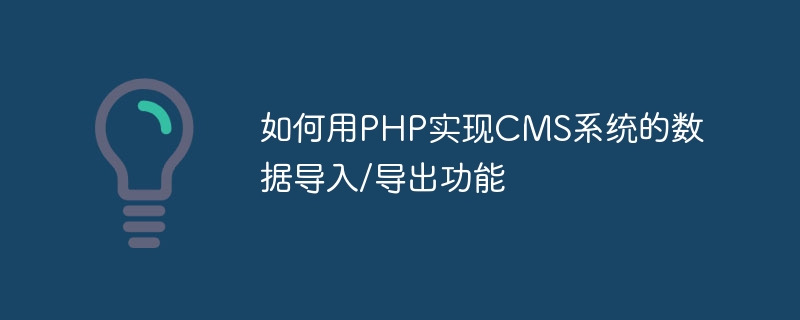

How to use PHP to implement the data import/export function of the CMS system
In modern society, CMS (Content Management System) is widely used in websites and applications In development. In the CMS system, the data import and export functions are very important. This article will introduce how to use PHP to implement the data import/export function of the CMS system and give corresponding code examples.
1. Implementation of data import function
The data import function allows users to import external data into the CMS system. Below is a sample code that demonstrates how to use PHP to implement the data import function.
<?php
// 处理数据导入的代码
if(isset($_FILES['file']) && $_FILES['file']['error'] == 0){
$file = $_FILES['file']['tmp_name'];
// 解析文件格式,这里以CSV文件为例
if(isset($_POST['format']) && $_POST['format'] == 'csv'){
$handle = fopen($file, 'r');
// 循环读取文件中的每行数据
while(($data = fgetcsv($handle, 10000, ',')) !== false){
// 在此处理每一行的导入逻辑
// 将数据插入到CMS数据库中
// ...
}
fclose($handle);
}
echo "数据导入成功!";
}
?>
<form action="import.php" method="post" enctype="multipart/form-data">
<input type="file" name="file" />
<select name="format">
<option value="csv">CSV</option>
<option value="xml">XML</option>
<!-- 其他格式的选项 -->
</select>
<button type="submit">导入</button>
</form>Through the above code, in the background of the CMS system, the user can select the file and file format to be imported. After clicking the "Import" button, the file will be uploaded to the server and parsed.
2. Implementation of data export function
The data export function allows users to export data in the CMS system to external files. Below is a sample code that demonstrates how to use PHP to implement the data export function.
<?php
// 处理数据导出的代码
if(isset($_POST['export'])){
// 查询CMS数据库中的数据,这里以SQL查询为例
$query = "SELECT * FROM `table` WHERE `condition`";
$result = mysqli_query($conn, $query);
// 生成导出文件的格式,这里以CSV文件为例
$filename = "export.csv";
$handle = fopen($filename, 'w');
// 写入表头
$columns = array("列1", "列2", "列3"); // 替换为实际的列名
fputcsv($handle, $columns);
// 写入数据
while($row = mysqli_fetch_array($result)){
fputcsv($handle, $row);
}
fclose($handle);
// 下载导出文件
header('Content-Type: application/csv');
header('Content-Disposition: attachment; filename='.$filename);
readfile($filename);
exit;
}
?>
<form action="export.php" method="post">
<button type="submit" name="export">导出</button>
</form>Through the above code, in the background of the CMS system, the user can click the "Export" button to export the data in the system as a CSV file and automatically download it locally.
Summary
This article introduces how to use PHP to implement the data import/export function of the CMS system, and gives corresponding code examples. Through the above code, external data can be easily imported into the CMS system and the data in the system can be exported to external files, which is very convenient and practical. Of course, in actual applications, appropriate improvements and adjustments need to be made according to specific needs.
The above is the detailed content of How to use PHP to implement the data import/export function of CMS system. For more information, please follow other related articles on the PHP Chinese website!